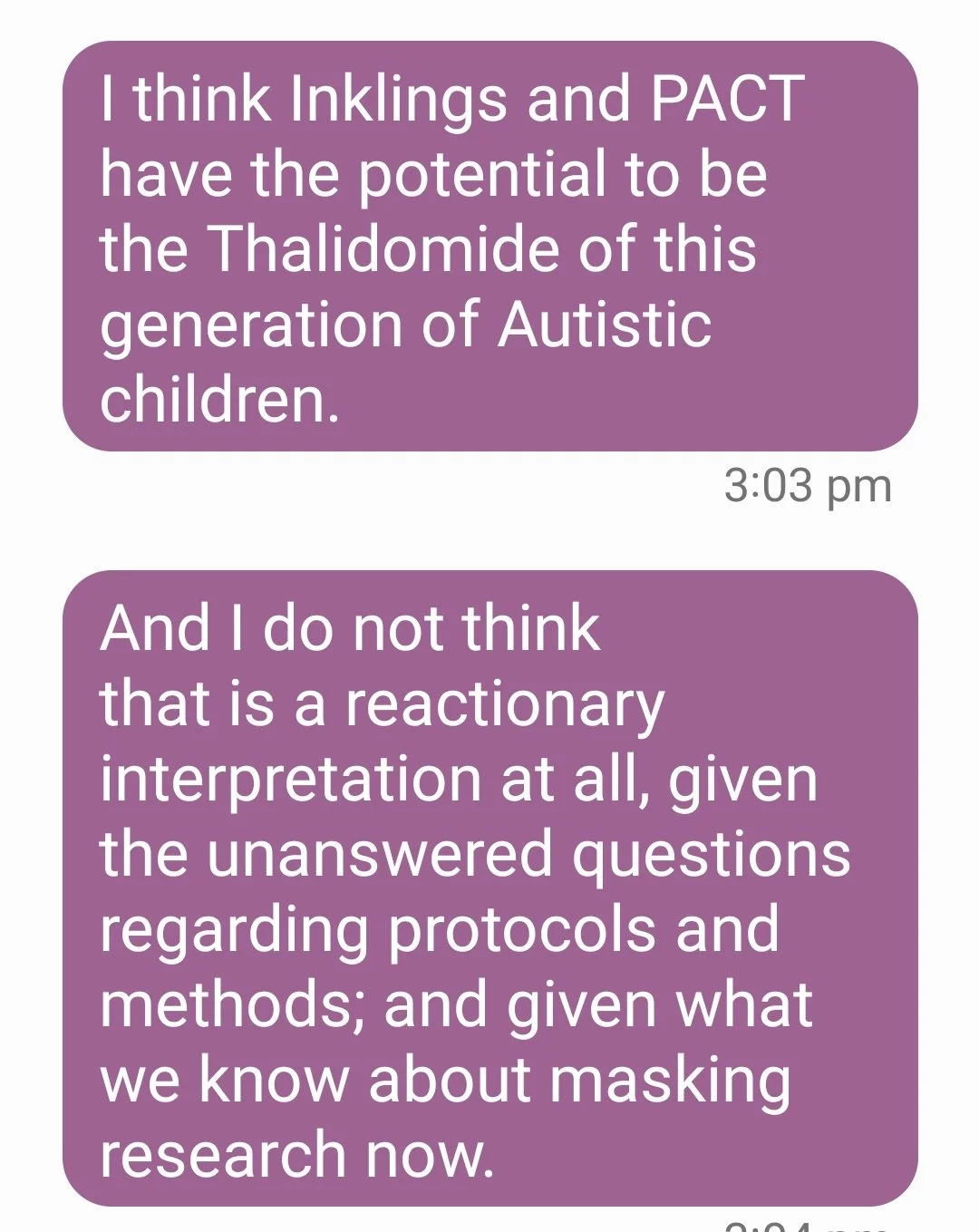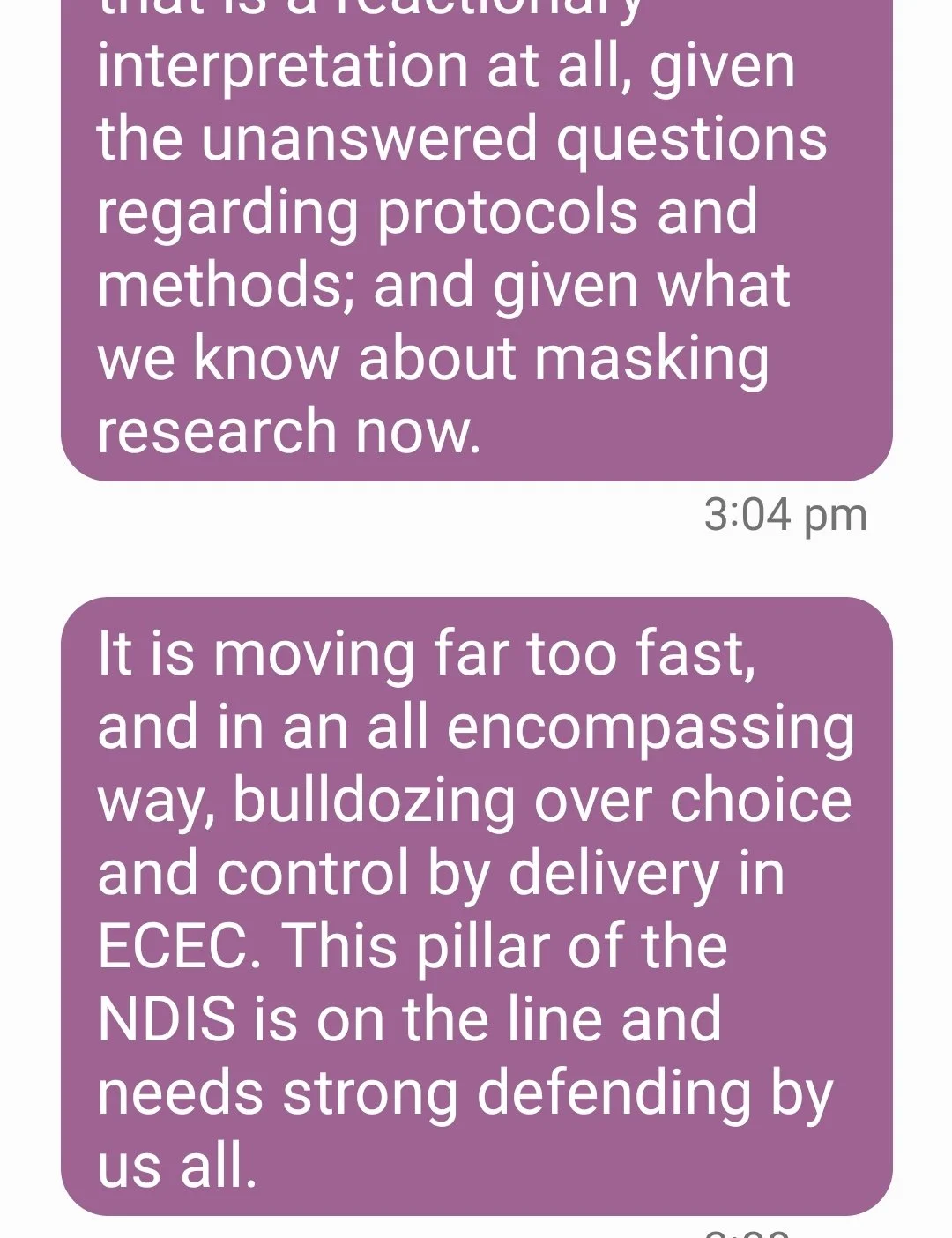could inklings cause masking in babies - or speed it up? How would we know?
A pilot program called ‘Inklings’ is proposed to be rolled out via the NDIS in South Australia. It has already been tested with 700 Western Australian families through the WA Community Health Service.
The purpose of the experimental program is to gather data to test the essence of the hypothesis of Professor Jonathon Green and Andrew Whitehouse: that pre-emptive intervention with babies showing signs of Autism, through training the parents of those babies to play with them in neurotypical ways (hint: the parents are probably Autistic too) can make those babies seem less Autistic.
And if they seem less Autistic on the outside, they won’t need as much support. Right?
Wrong.
Why is the government backing this?
In essence, because they reckon it’ll save them money on the NDIS. If babies seem less Autie on the outside, they may not meet the criteria for diagnosis, or the NDIS. Dollars saved.
The biggest problem with this of course is that any Autistic person will tell you that our social and communication differences are really only a small visible part of what Autism is. Behaviourists focus on this because they are concerned with the observable, the external. Autism, though, is a largely internal experience, as Autistic advocates have said rather pointedly for decades.
Sensory processing needs are a huge part of the picture and emotion regulation differences are too. We often need targeted and specific supports to navigate these. Also, differences in the regulation of attention; differences in sleep, eating, toileting, are all complicated by differences in interoceptive awareness (sensing your body and what it is doing). The list goes on.
Without support, life is challenging and you can easily sink. Many do.
Yet in many ways, our social and communication differences are the easiest part to “fix” about us, in that…you don’t need to fix them at all.
We often need facilitation - AAC and AUSLAN are beautiful things - and we need changed attitudes around us. If we were to experience less discrimination we would be much less ‘disabled’ day to day. But we do not need to change how we are. How we are is fine.
So changing the ‘outside’ or ‘visible’ bit of an Autistic child is really just working on the tip of the iceberg. There’s still a whole iceberg underneath. And, when we change the tip of the iceberg, but the rest is still floating underneath, you will still get catastrophe in the end. Titanic, anyone? The bit that sunk the ship was actually the part underneath the water.
I think the Titanic kiss of death of that iceberg is a pretty good analogy for what will ultimately happen if we start approaching Autism primarily on the basis of external signs through Foundational supports.
If we focus on training away surface social and communication differences through these babies parents - and do not focus on supporting the whole child and the depth of their Autistic experience - we will be producing a cohort of children facing Titanic endings.
For two reasons: we are ignoring the iceberg under the water; and we are melting the tip so that clinicians no longer know it is there. This is dangerous. Teaching children to mask so they fall just beneath the diagnostic threshold denies them support with all their other needs - because as we know, diagnosis is materially linked to support.
Masking - or social assimilation - is also a ‘key and unique’ risk indicator for suicide in Autistic people. Learning how to fit in and seem like other people kills Autistics at very high rates. Women and girls are masking experts - and it is thought this is one reason so many of us are late diagnosed, with lives marked by suffering and struggle, due to the delay in accessing support.
Melting the tip of the iceberg is the last thing we should be doing. We need it so we can get help.
Light metaphor aside: all of this is actually really scary to think about, considering 160 babies were already put through this program, and another 700 in WA. Is anyone tracking those kids for adverse outcomes in their teens and adulthood? Surely? As a late-diagnosed Autistic woman, I am incredibly worried for them. This is not abstract for me, not in any way.
These are little people with their whole lives ahead. They deserve, and have a right under the UNCRC 1989, our caution.
Here is the thing though: Telethon Kids Institute (the provider of Inklings) have denied publicly that this program teaches babies to mask, when asked.
Notably, they have provided zero evidence to back this statement. When they have been asked “how do you know it doesn’t?” they have avoided answering. In all media done since the announcement of Inklings in SA in January, there has been no straight approach to this question.
I think the reason why is very simple: they don’t know. They have no idea at all, because the idea that the phenomenon produced by Inklings and observed by the researchers may actually be an observation of the emergence of masking behaviour is yet to be rigorously examined. In the meantime, babies are being put through the program. It screeches future class action, to be frank.
I have personally, repeatedly, asked Professor Andrew Whitehouse and Professor Jonathon Green this question in writing: and received no response. Why they feel entitled to ignore this question from an Autistic person, I have no idea. What I have asked them is this:
Is there a possibility that the phenomenon of change you have observed in your research is actually the emergence of masking behaviour?
Is there a possibility that the mechanisms used in your trials may be similar to those that social mechanisms which construct masking behaviour in children ‘in the wild’?
Is there a possibility you are inducing it, or accelerating it - and in the process, putting these children on a path to self-harm and suicide?
How do you know?
How do you know?
One of the key aspects of doing research is theory testing. Theory construction, data collection, coding and analysis, and testing theory against the evidence. This is a huge over-simplication of the process, and it differs by discipline, so my apologies to researchers reading for this crude explanation.
However, it is a similar kind of process to law: which is the practice of grasping the law, gathering the facts, and applying the law to the facts to construct an argument. Research cycles around and around through loops of deductive and inductive reasoning, to try to solidify the best thinking possible.
Your argument is only as good as your evidence, and your evidence is influenced by your approach, and foundational assumptions. A weakness of any research is the assumptions of the researcher: what first principles they allow, and what Achilles heel of bias they may have, that they do not realise they have.
A key assumption of the behaviourist when approaching Autistic children is usually that less outward Autistic traits is a good thing. The closer to typical, the better. But from masking research, we now know that actually - this is a bad thing. Approximating typicality kills Autistic people.
It may be more inconvenient for others that we are more Actually Autistic, but it is more likely to prolong our lives.
So it is interesting, really interesting, to realise that the researchers involved in this study, trial, and pilot have likely started with a flawed ableist assumption that less outward atypical behaviours = higher quality of life.
There seems to be no evidence of that; and plenty of the opposite, now.
This assumption, I believe, has tainted both the development and testing of research theory from the get-go, and also blinkered them against seeing highly relevant research on masking that was developing apace in parallel - in Britain, the US and Australia - that would have provided a different and very important view of the phenomenon they observed.
They failed to ask the most basic of research questions: what other or larger phenomenon may this be a part of? What other explanation could there be for what I have observed? I believe they failed to ask this, because behaviourism is such a headily strong, disciplining power (as Foucault might say of this whole shenanigan).
Whether or not Inklings produces masking behaviour remains an open question, but it is one that must be answered, in research - or perhaps one day will be answered at law, if the babies in this program grow to become impacted adults and seek redress for harm. I have a sizeable file for them, should they need it, that I will continue to keep current as the years progress, and if this push succeeds.
That open question is being examined at the moment via a report made to the ethics review committee at Princess Margaret Hospital - the committee that approved the original trials.
It will be interesting to hear the outcome of that review.
My concerns about Inklings and its cousin - PACT therapy - are best summarised below in a text sent to another advocate on the issue.
I think we should all be writing to our State Premiers - who are commendably resisting Shorten’s fast moves - and encouraging them to slow this runaway train right, right down.
x Sarah






